Ortiz de Montellano Paul R.(Ed.) Cytochrome P450. Structure, Mechanism, and Biochemistry
Подождите немного. Документ загружается.

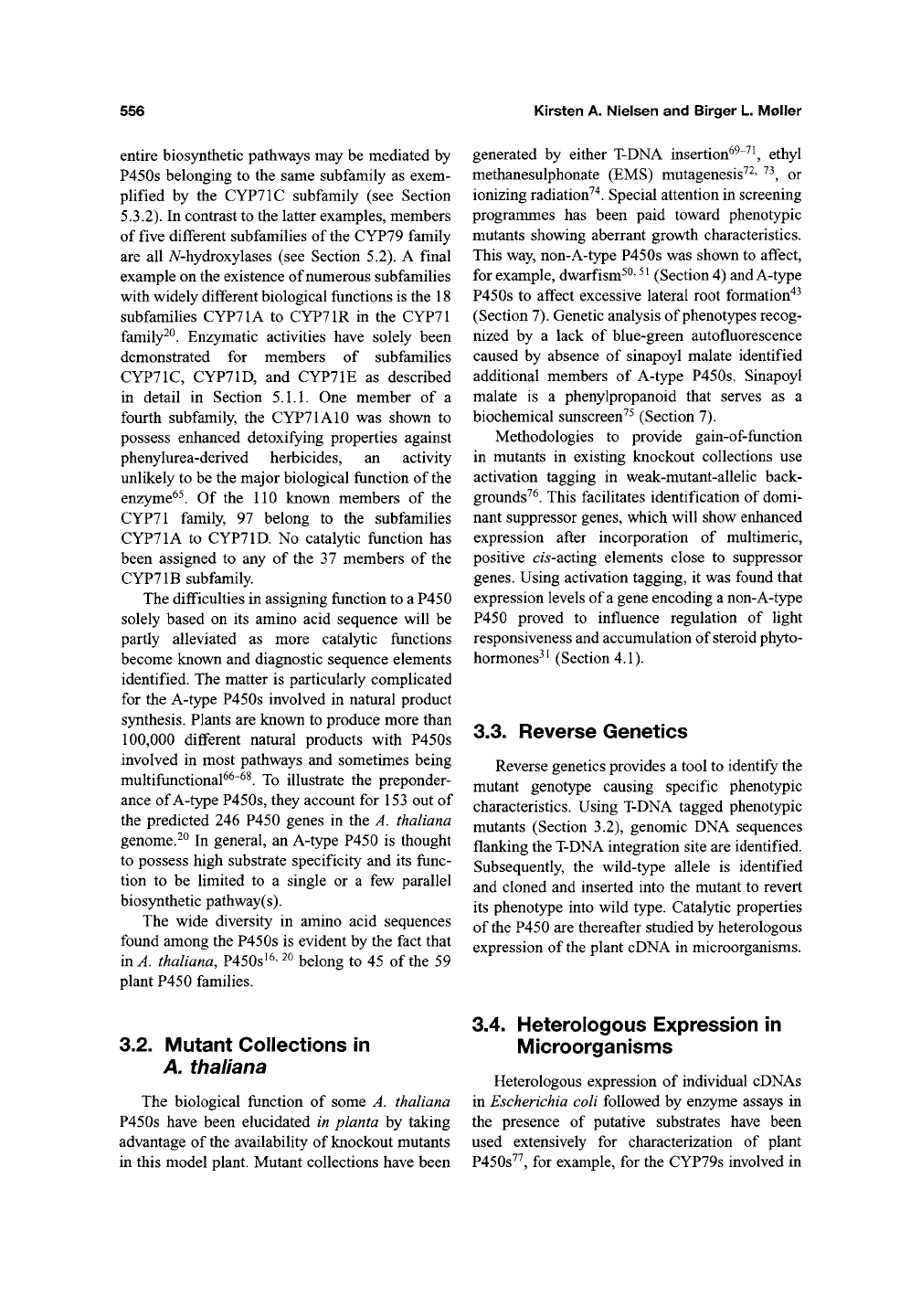
556
Kirsten A. Nielsen and Birger L. Moller
entire biosynthetic pathways may be mediated by
P450s belonging to the same subfamily as exem-
plified by the CYP71C subfamily (see Section
5.3.2). In contrast to the latter examples, members
of five different subfamilies of the CYP79 family
are all A/-hydroxylases (see Section 5.2). A final
example on the existence of numerous subfamilies
with widely different biological functions is the 18
subfamilies CYP71A to CYP71R in the CYP71
family^^. Enzymatic activities have solely been
demonstrated for members of subfamilies
CYP71C, CYP71D, and CYP71E as described
in detail in Section
5.1.1.
One member of a
fourth subfamily, the CYP71A10 was shown to
possess enhanced detoxifying properties against
phenylurea-derived herbicides, an activity
unlikely to be the major biological fiinction of the
enzyme^^. Of the 110 known members of the
CYP71 family, 97 belong to the subfamilies
CYP71A to CYP71D. No catalytic function has
been assigned to any of the 37 members of the
CYP71B subfamily
The difficulties in assigning function to a P450
solely based on its amino acid sequence will be
partly alleviated as more catalytic functions
become known and diagnostic sequence elements
identified. The matter is particularly complicated
for the A-type P450s involved in natural product
synthesis. Plants are known to produce more than
100,000 different natural products with P450s
involved in most pathways and sometimes being
multifunctional^^"^^. To illustrate the preponder-
ance of A-type P450s, they account for 153 out of
the predicted 246 P450 genes in the A. thaliana
genome.^^ In general, an A-type P450 is thought
to possess high substrate specificity and its func-
tion to be limited to a single or a few parallel
biosynthetic pathway(s).
The wide diversity in amino acid sequences
found among the P450s is evident by the fact that
in A. thaliana, P450s'^'
^o
belong to 45 of the 59
plant P450 families.
generated by either T-DNA insertion^^"^^ ethyl
methanesulphonate (EMS) mutagenesis^^'
^'^,
or
ionizing radiation'''^. Special attention in screening
programmes has been paid toward phenotypic
mutants showing aberrant growth characteristics.
This way, non-A-type P450s was shown to affect,
for example, dwarf
ism^*^'
^^
(Section 4) and A-type
P450s to affect excessive lateral root formation"^^
(Section
7).
Genetic analysis of phenotypes recog-
nized by a lack of blue-green autofluorescence
caused by absence of sinapoyl malate identified
additional members of A-type P450s. Sinapoyl
malate is a phenylpropanoid that serves as a
biochemical sunscreen^^ (Section 7).
Methodologies to provide gain-of-function
in mutants in existing knockout collections use
activation tagging in weak-mutant-allelic back-
grounds^^. This facilitates identification of domi-
nant suppressor genes, which will show enhanced
expression after incorporation of multimeric,
positive c/5-acting elements close to suppressor
genes.
Using activation tagging, it was found that
expression levels of a gene encoding a non-A-type
P450 proved to influence regulation of light
responsiveness and accumulation of steroid phyto-
hormones^' (Section 4.1).
3.3. Reverse Genetics
Reverse genetics provides a tool to identify the
mutant genotype causing specific phenotypic
characteristics. Using T-DNA tagged phenotypic
mutants (Section 3.2), genomic DNA sequences
flanking the T-DNA integration site are identified.
Subsequently, the wild-type allele is identified
and cloned and inserted into the mutant to revert
its phenotype into wild type. Catalytic properties
of
the
P450 are thereafter studied by heterologous
expression of
the
plant cDNA in microorganisms.
3.2. Mutant Collections in
A.
thaliana
The biological function of some A. thaliana
P450s have been elucidated in planta by taking
advantage of the availability of knockout mutants
in this model plant. Mutant collections have been
3.4. Heterologous Expression in
Microorganisms
Heterologous expression of individual cDNAs
in Escherichia coli followed by enzyme assays in
the presence of putative substrates have been
used extensively for characterization of plant
P450s^^, for example, for the CYP79s involved in
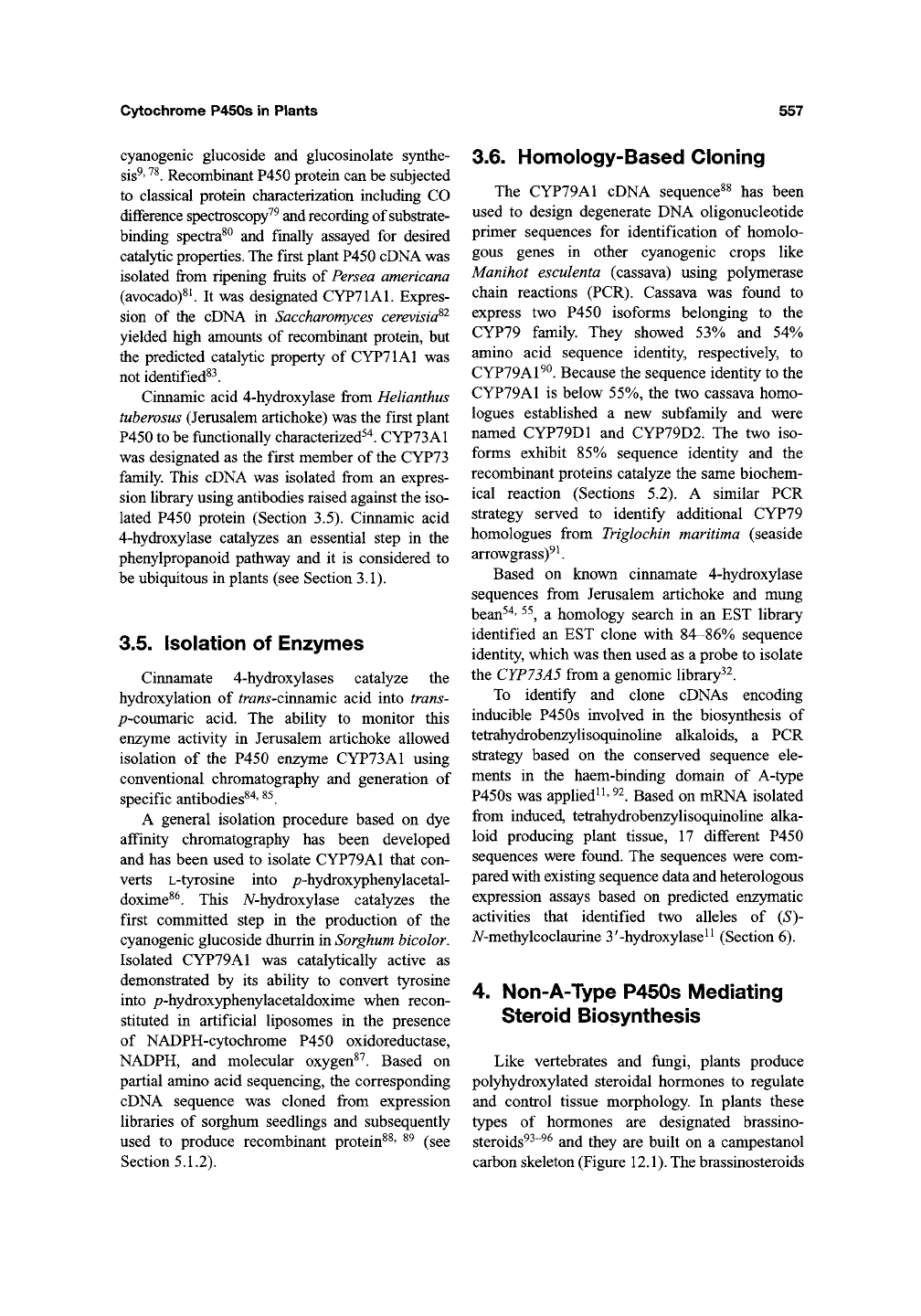
Cytochrome P450s in Plants
557
cyanogenic glucoside and glucosinolate synthe-
sis^'
^^.
Recombinant P450 protein can be subjected
to classical protein characterization including CO
difference spectroscopy^^ and recording of substrate-
binding spectra^^ and finally assayed for desired
catalytic properties. The first plant P450 cDNA was
isolated from ripening fruits of
Persea
americana
(avocado)^ ^ It was designated CYP71A1. Expres-
sion of the cDNA in Saccharomyces cerevisia^^
yielded high amounts of recombinant protein, but
the predicted catalytic property of CYP71A1 was
not identified^^.
Cinnamic acid 4-hydroxylase from Helianthus
tuberosus (Jerusalem artichoke) was the first plant
P450 to be fimctionally characterized^'*. CYP73A1
was designated as the first member of the CYP73
family. This cDNA was isolated from an expres-
sion library using antibodies raised against the iso-
lated P450 protein (Section 3.5). Cinnamic acid
4-hydroxylase catalyzes an essential step in the
phenylpropanoid pathway and it is considered to
be ubiquitous in plants (see Section 3.1).
3.5. Isolation of Enzymes
Cinnamate 4-hydroxylases catalyze the
hydroxylation of ^ra«5-cinnamic acid into trans-
/7-coumaric acid. The ability to monitor this
enzyme activity in Jerusalem artichoke allowed
isolation of the P450 enzyme CYP73A1 using
conventional chromatography and generation of
specific antibodies^"^' ^^.
A general isolation procedure based on dye
affinity chromatography has been developed
and has been used to isolate CYP79A1 that con-
verts L-tyrosine into /7-hydroxyphenylacetal-
doxime^^. This A^-hydroxylase catalyzes the
first committed step in the production of the
cyanogenic glucoside dhurrin in Sorghum bicolor.
Isolated CYP79A1 was catalytically active as
demonstrated by its ability to convert tyrosine
into /?-hydroxyphenylacetaldoxime when recon-
stituted in artificial liposomes in the presence
of NADPH-cytochrome P450 oxidoreductase,
NADPH, and molecular oxygen^^. Based on
partial amino acid sequencing, the corresponding
cDNA sequence was cloned from expression
libraries of sorghum seedlings and subsequently
used to produce recombinant protein^^' ^^ (see
Section 5.1.2).
3.6. Homology-Based Cloning
The CYP79A1 cDNA sequence^^ has been
used to design degenerate DNA oligonucleotide
primer sequences for identification of homolo-
gous genes in other cyanogenic crops like
Manihot esculenta (cassava) using polymerase
chain reactions (PCR). Cassava was found to
express two P450 isoforms belonging to the
CYP79 family They showed 53% and 54%
amino acid sequence identity, respectively, to
CYP79A1^^.
Because the sequence identity to the
CYP79A1 is below 55%, the two cassava homo-
logues established a new subfamily and were
named CYP79D1 and CYP79D2. The two iso-
forms exhibit 85% sequence identity and the
recombinant proteins catalyze the same biochem-
ical reaction (Sections 5.2). A similar PCR
strategy served to identify additional CYP79
homologues from Triglochin maritima (seaside
arrowgrass)^^.
Based on known cinnamate 4-hydroxylase
sequences from Jerusalem artichoke and mung
bean^"^' ^^, a homology search in an EST library
identified an EST clone with 84-86% sequence
identity, which was then used as a probe to isolate
the CYP73A5 from a genomic library^^.
To identify and clone cDNAs encoding
inducible P450s involved in the biosynthesis of
tetrahydrobenzylisoquinoline alkaloids, a PCR
strategy based on the conserved sequence ele-
ments in the haem-binding domain of A-type
P450s was applied^
^' ^^.
Based on mRNA isolated
from induced, tetrahydrobenzylisoquinoline alka-
loid producing plant tissue, 17 different P450
sequences were found. The sequences were com-
pared with existing sequence data and heterologous
expression assays based on predicted enzymatic
activities that identified two alleles of (S)-
iV-methylcoclaurine 3'-hydroxylase^^ (Section 6).
4. Non-A-Type P450s Mediating
Steroid Biosynthesis
Like vertebrates and fungi, plants produce
polyhydroxylated steroidal hormones to regulate
and control tissue morphology. In plants these
types of hormones are designated brassino-
steroids^^"^^ and they are built on a campestanol
carbon skeleton (Figure
12.1).
The brassinosteroids
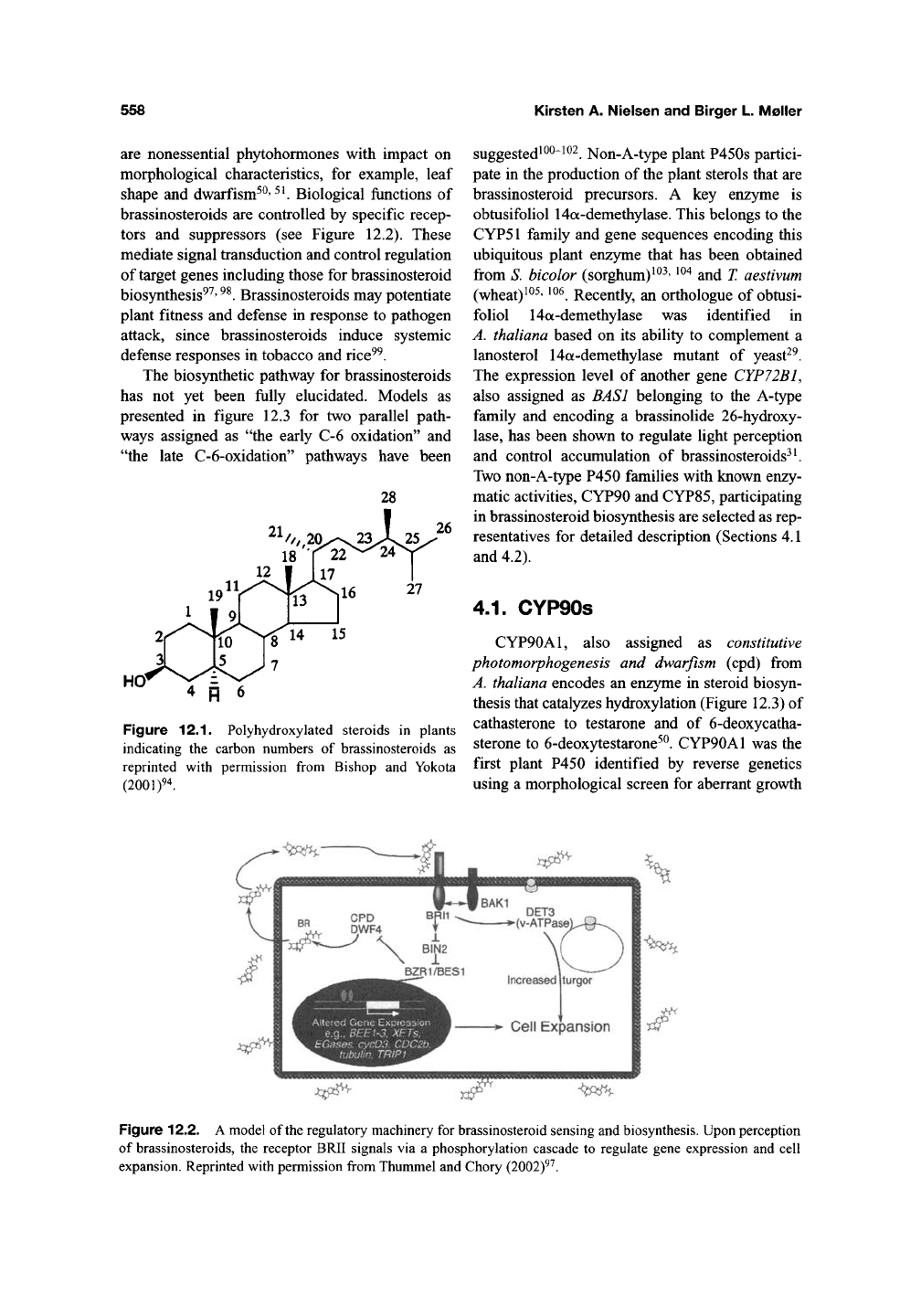
558
Kirsten A. Nielsen and Birger L. Moller
are nonessential phytohormones with impact on
morphological characteristics, for example, leaf
shape and dwarfism^^' ^^ Biological functions of
brassinosteroids are controlled by specific recep-
tors and suppressors (see Figure 12.2). These
mediate signal transduction and control regulation
of target genes including those for brassinosteroid
biosynthesis^^'
^^.
Brassinosteroids may potentiate
plant fitness and defense in response to pathogen
attack, since brassinosteroids induce systemic
defense responses in tobacco and rice^^.
The biosynthetic pathway for brassinosteroids
has not yet been fully elucidated. Models as
presented in figure 12.3 for two parallel path-
ways assigned as "the early C-6 oxidation" and
"the late C-6-oxidation" pathways have been
4 ^ 6
Figure 12.1. Polyhydroxylated steroids in plants
indicating the carbon numbers of brassinosteroids as
reprinted with permission from Bishop and Yokota
(2001)94.
suggested^^^~^^^. Non-A-type plant P450s partici-
pate in the production of the plant sterols that are
brassinosteroid precursors. A key enzyme is
obtusifoliol 14a-demethylase. This belongs to the
CYP51 family and gene sequences encoding this
ubiquitous plant enzyme that has been obtained
from S. bicolor (sorghum)^^^'
^^^
and
T.
aestivum
(wheat)^^^' ^^^. Recently, an orthologue of obtusi-
foliol 14a-demethylase was identified in
A.
thaliana based on its ability to complement a
lanosterol 14a-demethylase mutant of yeast^^.
The expression level of another gene CYP72B1,
also assigned as BASl belonging to the A-type
family and encoding a brassinolide 26-hydroxy-
lase,
has been shown to regulate light perception
and control accumulation of brassinosteroids^ ^
Two non-A-type P450 families with known enzy-
matic activities, CYP90 and CYP85, participating
in brassinosteroid biosynthesis are selected as rep-
resentatives for detailed description (Sections 4.1
and 4.2).
4.1.
CYP90S
CYP90A1,
also assigned as constitutive
photomorphogenesis and dwarfism (cpd) from
A.
thaliana encodes an enzyme in steroid biosyn-
thesis that catalyzes hydroxylation (Figure 12.3) of
cathasterone to testarone and of 6-deoxycatha-
sterone to 6-deoxytestarone^^. CYP90A1 was the
first plant P450 identified by reverse genetics
using a morphological screen for aberrant growth
Figure 12.2. A model of the regulatory machinery for brassinosteroid sensing and biosynthesis. Upon perception
of brassinosteroids, the receptor BRII signals via a phosphorylation cascade to regulate gene expression and cell
expansion. Reprinted with permission from Thummel and Chory (2002)^^.
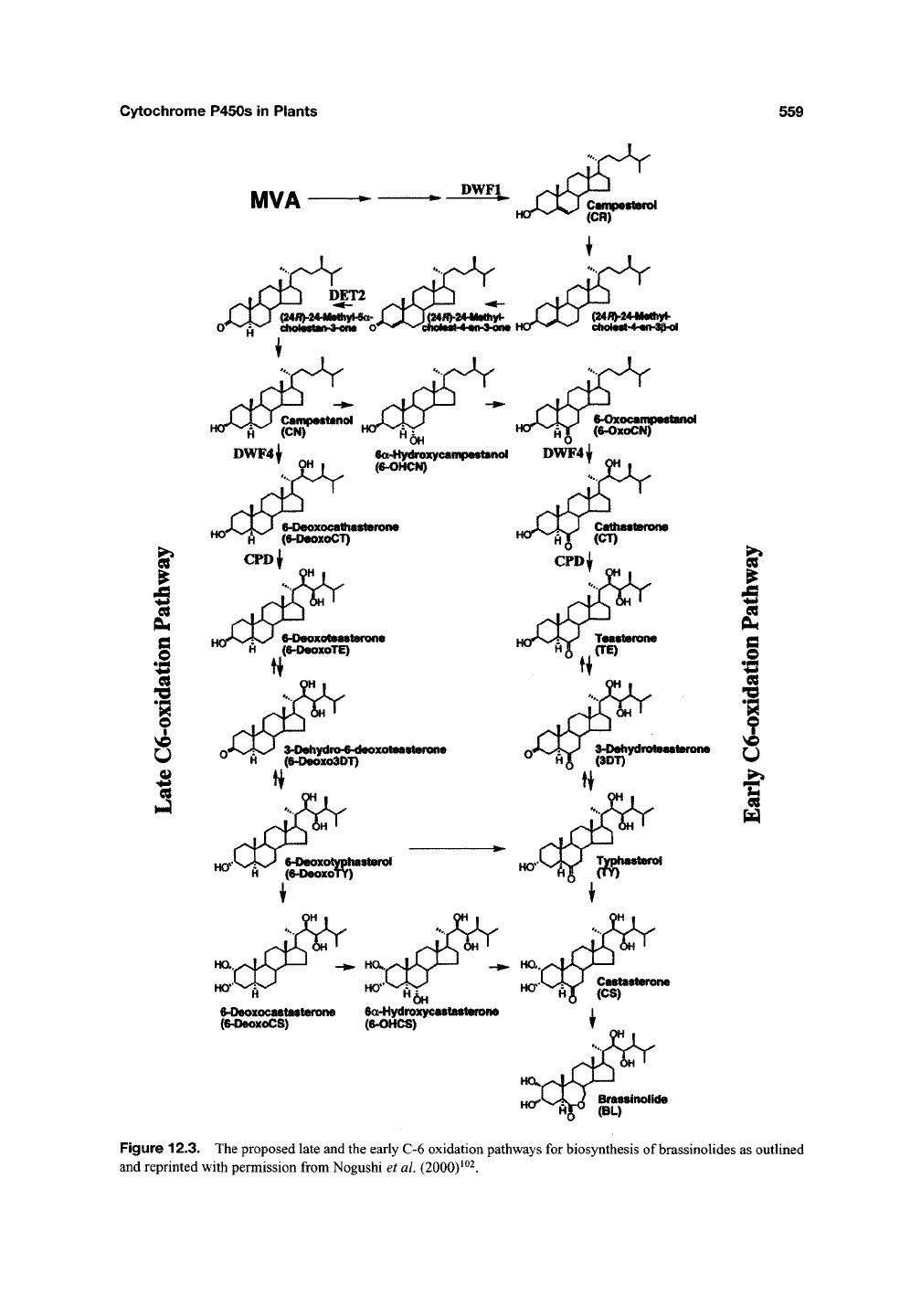
Cytochrome P450s in Plants
559
(24fl)'24-IIMItyl-
CllOlMt«4<«lV2^-Oi
$-Qxoc«nipe«imMH
($-OxoCN)
r
I
•I
1
€8
Catliast&rone
(CT)
" H (6-D«»xo30T>
Ha*
e-Peoxoodftliisterone $a4lyiiroxycast8Slei0ii«
(6-DeoxoCS) (6<OHC$)
r
I
!
t
Bfassinoltite
Figure 12.3. The proposed late and the early C-6 oxidation pathways for biosynthesis of brassinolides as outlined
and reprinted with permission from Nogushi et al. (2000)^^2.
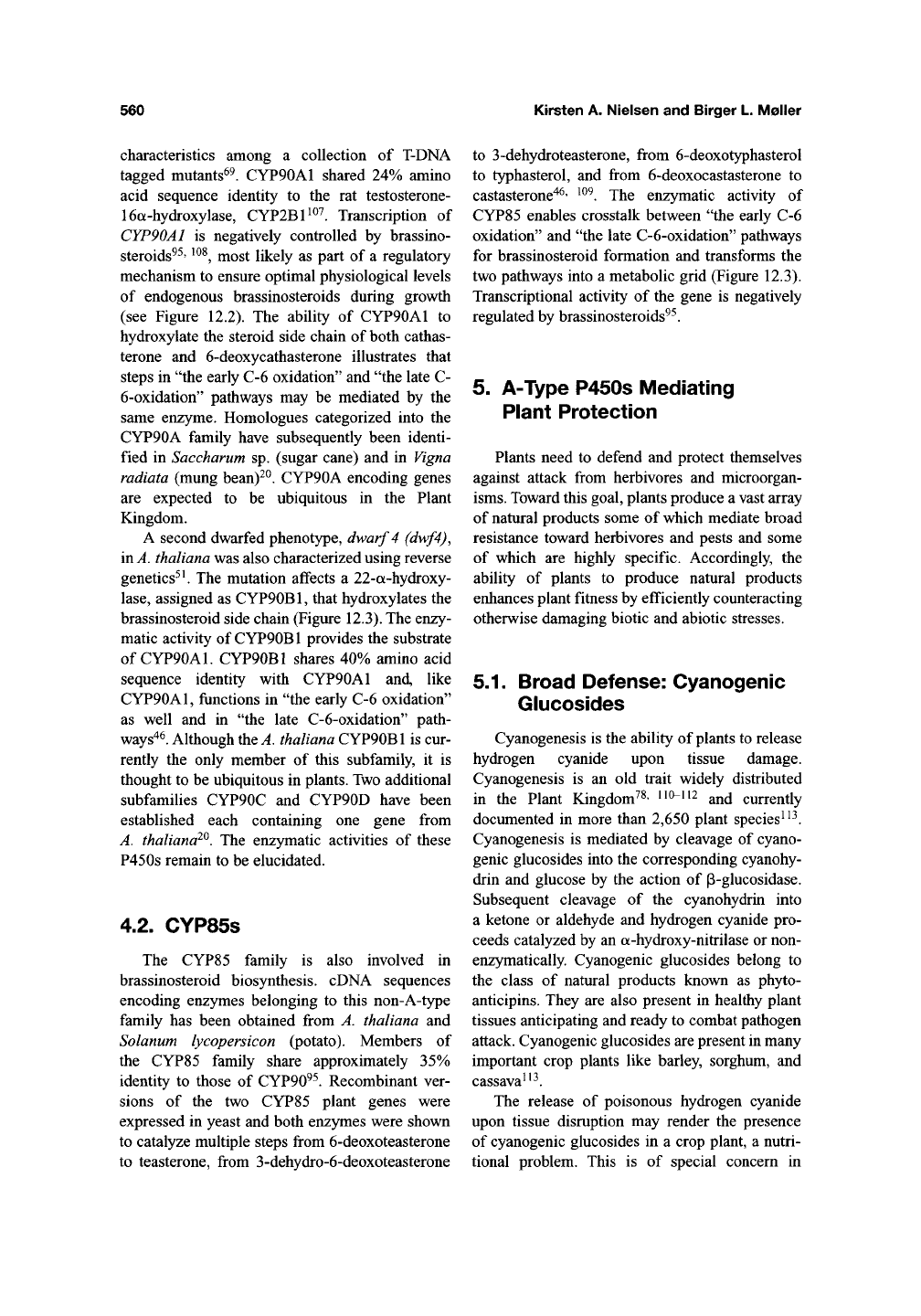
560
Kirsten A. Nielsen and Birger L. Meller
characteristics among a collection of T-DNA
tagged mutants^^. CYP90A1 shared 24% amino
acid sequence identity to the rat testosterone-
16a-hydroxylase, CYP2B1^^^. Transcription of
CYP90A1 is negatively controlled by brassino-
steroids^^' ^^^, most likely as part of a regulatory
mechanism to ensure optimal physiological levels
of endogenous brassinosteroids during growth
(see Figure 12.2). The ability of CYP90A1 to
hydroxylate the steroid side chain of both cathas-
terone and 6-deoxycathasterone illustrates that
steps in "the early C-6 oxidation" and "the late C-
6-oxidation" pathways may be mediated by the
same enzyme. Homologues categorized into the
CYP90A family have subsequently been identi-
fied in Saccharum sp. (sugar cane) and in Vigna
radiata (mung bean)-^^. CYP90A encoding genes
are expected to be ubiquitous in the Plant
Kingdom.
A second dwarfed phenotype, dwarf 4 (dwf4),
in
A.
thaliana was also characterized using reverse
genetics^ ^ The mutation affects a 22-a-hydroxy-
lase,
assigned as CYP90B1, that hydroxylates the
brassinosteroid side chain (Figure 12.3). The enzy-
matic activity of
CYP90B1
provides the substrate
of
CYP90A1.
CYP90B1 shares 40% amino acid
sequence identity with CYP90A1 and, like
CYP90A1,
functions in "the early C-6 oxidation"
as well and in "the late C-6-oxidation" path-
ways'^.
Although the
A.
thaliana CYP90B1 is cur-
rently the only member of this subfamily, it is
thought to be ubiquitous in plants. Two additional
subfamilies CYP90C and CYP90D have been
established each containing one gene from
A.
thaliana^^. The enzymatic activities of these
P450s remain to be elucidated.
4.2.
CYP85S
The CYP85 family is also involved in
brassinosteroid biosynthesis. cDNA sequences
encoding enzymes belonging to this non-A-type
family has been obtained from A. thaliana and
Solanum lycopersicon (potato). Members of
the CYP85 family share approximately 35%
identity to those of CYP90^^. Recombinant ver-
sions of the two CYP85 plant genes were
expressed in yeast and both enzymes were shown
to catalyze multiple steps from 6-deoxoteasterone
to teasterone, from 3-dehydro-6-deoxoteasterone
to 3-dehydroteasterone, from 6-deoxotyphasterol
to typhasterol, and from 6-deoxocastasterone to
castasterone'^' ^^^. The enzymatic activity of
CYP85 enables crosstalk between "the early C-6
oxidation" and "the late C-6-oxidation" pathways
for brassinosteroid formation and transforms the
two pathways into a metabolic grid (Figure 12.3).
Transcriptional activity of the gene is negatively
regulated by brassinosteroids^^.
5. A-Type P450s Mediating
Plant Protection
Plants need to defend and protect themselves
against attack from herbivores and microorgan-
isms.
Toward this goal, plants produce a vast array
of natural products some of which mediate broad
resistance toward herbivores and pests and some
of which are highly specific. Accordingly, the
ability of plants to produce natural products
enhances plant fitness by efficiently counteracting
otherwise damaging biotic and abiotic stresses.
5.1.
Broad Defense: Cyanogenic
Glucosides
Cyanogenesis is the ability of plants to release
hydrogen cyanide upon tissue damage.
Cyanogenesis is an old trait widely distributed
in the Plant Kingdom^^' 110-112 ^nd currently
documented in more than 2,650 plant
species^
^^.
Cyanogenesis is mediated by cleavage of cyano-
genic glucosides into the corresponding cyanohy-
drin and glucose by the action of p-glucosidase.
Subsequent cleavage of the cyanohydrin into
a ketone or aldehyde and hydrogen cyanide pro-
ceeds catalyzed by an a-hydroxy-nitrilase or non-
enzymatically. Cyanogenic glucosides belong to
the class of natural products known as phyto-
anticipins. They are also present in healthy plant
tissues anticipating and ready to combat pathogen
attack. Cyanogenic glucosides are present in many
important crop plants like barley, sorghum, and
cassava^
^^.
The release of poisonous hydrogen cyanide
upon tissue disruption may render the presence
of cyanogenic glucosides in a crop plant, a nutri-
tional problem. This is of special concern in

Cytochrome P450s in Plants
561
cassava where use of this crop as a staple food
requires careful processing to remove the
cyanogenic glucosides or their degradation prod-
ucts before consumption^
^'^.
In barley, major focus
has been on cyanide potential in malt (5-day-old
seedlings) and breeding programs have estab-
lished genotypes assigned as low, medium, and
high producers^
^^.
Despite domestication and con-
trolled breeding, null-mutants have neither been
identified in cassava nor in barley. It has been
hypothesized that the ability of humans to remove
cyanide by food processing explains why humans
have continued to select and use cyanogenic crops
as important components in the diet. In the early
phases of plant breeding, selection of cyanogenic
crops may have afforded protection from herbi-
vore damage and may have helped to prevent theft
of
the
crop^^^.
Cyanogenic glucosides are derived from the
amino acids L-valine, L-isoleucine, L-leucine,
L-phenylalanine, and L-t3a*osine and from the non-
protein amino acid cyclopentenyl glycine^^' ^^^.
Typically, a cyanogenic plant contains only one or
two different cyanogenic glucosides. The biosyn-
thetic pathway for cyanogenic glucosides has been
elucidated using dhurrin production in S. bicolor
as a model system. A general scheme for biosyn-
thesis of cyanogenic glucosides involving two
membrane-bound P450s and a soluble UDPG-
glucosyltransferase was established as described
below (see Figure 12.4).
5.1.1.
Biosynthesis
Initial studies on the biosynthetic pathway for
the L-tyrosine-derived cyanogenic glucoside dhur-
rin demonstrated that the covalent bond linking
the
a-and
p-carbon atoms in L-tyrosine was
preserved throughout dhurrin synthesis^ ^^.
Subsequently, it was shown that the C-N bond in
the parent amino acid is preserved during the
biosynthetic
process^
^^.
These studies were car-
ried out by administration of double-labeled tyro-
sine to excised, biosynthetically active sorghum
seedlings. Based on these observations, a biosyn-
thetic pathway including an aldoxime, a nitrile,
and an a-hydroxynitrile as intermediates was
proposed, although no such compounds were
detectable^
^^'
^^^.
A major breakthrough in the elu-
cidation of the dhurrin pathway was based on the
COOH
L-tyrosine
02 + NADPH
ic
HO
OH
NADP+
COOH
Af-hydroxytyro8ine
I / 02 + NADPH
1^
NADP+
" HO OH
MA^dihydroxytyrosine
{£)-/>-hydroxyphenyl-
acetaidoxime
xrx"
(2)-/>'hydroxyphenyl-
acetaldoxlme
XT'
p*hydroxyphenyi -
acetonttriie
1^02 + NADPH
|^NADP+
P450OX
p-hydroxymandetonitrile
CHO
1] +HCN
/>hydroxybenzaldehyde
Figure 12.4. The biosynthetic pathway for
the cyanogenic glucoside dhurrin is catalyzed
by two multifunctional cytochrome P450s,
CYP79A1,
and CYP71E1 (P450ox) and by a
glucosyltransferase, UGT85B1.
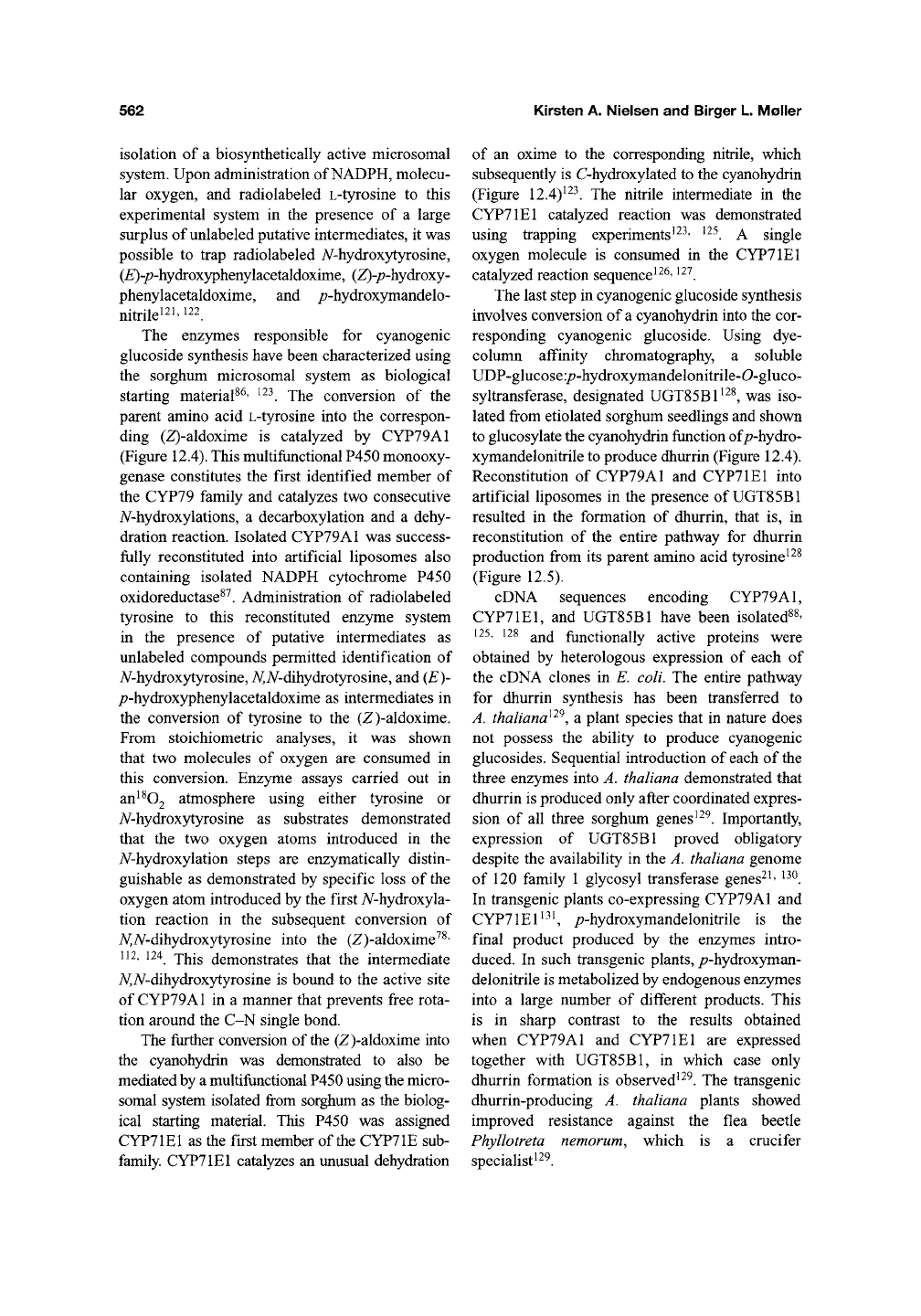
562
Kirsten
A.
Nielsen
and
Birger
L.
Moller
isolation
of a
biosynthetically active microsomal
system. Upon administration of NADPH, molecu-
lar oxygen,
and
radiolabeled L-tyrosine
to
this
experimental system
in the
presence
of a
large
surplus of unlabeled putative intermediates, it was
possible
to
trap radiolabeled A^-hydroxytyrosine,
(i^-/>-hydroxyphenylacetaldoxime, (Z)-/?-hydroxy-
phenylacetaldoxime,
and
/7-hydroxymandelo-
nitriiei2i,
122
The enzymes responsible
for
cyanogenic
glucoside synthesis have been characterized using
the sorghum microsomal system
as
biological
starting material^^'
^^^. The
conversion
of the
parent amino acid L-tyrosine into
the
correspon-
ding (Z)-aldoxime
is
catalyzed
by
CYP79A1
(Figure
12.4).
This multiftinctional P450 monooxy-
genase constitutes
the
first identified member
of
the CYP79 family and catalyzes two consecutive
iV-hydroxylations,
a
decarboxylation and
a
dehy-
dration reaction. Isolated CYP79A1 was success-
fully reconstituted into artificial liposomes also
containing isolated NADPH cytochrome P450
oxidoreductase^^. Administration
of
radiolabeled
tyrosine
to
this reconstituted enzyme system
in
the
presence
of
putative intermediates
as
unlabeled compounds permitted identification
of
7V-hydroxytyrosine, 7V,A^-dihydrotyrosine, and (£")-
/?-hydroxyphenylacetaldoxime
as
intermediates
in
the conversion
of
tyrosine
to the
(Z)-aldoxime.
From stoichiometric analyses,
it was
shown
that
two
molecules
of
oxygen
are
consumed
in
this conversion. Enzyme assays carried
out in
an^^02 atmosphere using either tyrosine
or
A^-hydroxytyrosine
as
substrates demonstrated
that
the two
oxygen atoms introduced
in the
A^-hydroxylation steps
are
enzymatically distin-
guishable
as
demonstrated by specific loss
of
the
oxygen atom introduced by the first A/-hydroxyla-
tion reaction
in the
subsequent conversion
of
A'^A^-dihydroxytyrosine into
the
(Z)-aldoxime^^'
112,
124 yj^jg demonstrates that
the
intermediate
A(;A^-dihydroxytyrosine
is
bound
to
the active site
of
CYP79A1
in a
manner that prevents free rota-
tion around the C-N single bond.
The further conversion of
the
(Z)-aldoxime into
the cyanohydrin
was
demonstrated
to
also
be
mediated by a multifunctional P450 using the micro-
somal system isolated from sorghum as the biolog-
ical starting material. This P450
was
assigned
CYP71E1 as the first member of
the
CYP71E sub-
family. CYP71E1 catalyzes an unusual dehydration
of
an
oxime
to the
corresponding nitrile, which
subsequently is C-hydroxylated to the cyanohydrin
(Figure 12.4)^^^.
The
nitrile intermediate
in the
CYP71E1 catalyzed reaction
was
demonstrated
using trapping experiments ^^^'
^^^. A
single
oxygen molecule
is
consumed
in the
CYP71E1
catalyzed reaction sequence^^^'
^^'^.
The last step in cyanogenic glucoside synthesis
involves conversion of
a
cyanohydrin into the cor-
responding cyanogenic glucoside. Using
dye-
column affinity chromatography,
a
soluble
UDP-glucose:/>-hydroxymandelonitrile-0-gluco-
syltransferase, designated UGT85B1'^^, was iso-
lated from etiolated sorghum seedlings and shown
to glucosylate the cyanohydrin function of/?-hydro-
xymandelonitrile to produce dhurrin (Figure 12.4).
Reconstitution
of
CYP79A1
and
CYP71E1 into
artificial liposomes
in
the presence
of
UGT85B1
resulted
in the
formation
of
dhurrin, that
is, in
reconstitution
of
the entire pathway
for
dhurrin
production from its parent amino acid tyrosine ^^^
(Figure 12.5).
cDNA sequences encoding CYP79A1,
CYP71E1,
and
UGT85B1 have been isolated^^'
125,
128 ^^^
functionally active proteins were
obtained
by
heterologous expression
of
each
of
the cDNA clones
in
E. coli. The entire pathway
for dhurrin synthesis
has
been transferred
to
A.
thaliana^^"^,
2i
plant species that
in
nature does
not possess
the
ability
to
produce cyanogenic
glucosides. Sequential introduction of each
of
the
three enzymes into A. thaliana demonstrated that
dhurrin is produced only after coordinated expres-
sion
of
all three sorghum genes'^^. Importantly,
expression
of
UGT85B1 proved obligatory
despite the availability
in
the A. thaliana genome
of 120 family
1
glycosyl transferase genes^^' ^^^.
In transgenic plants co-expressing CYP79A1
and
CYP71EU'^',
/7-hydroxymandelonitrile is the
final product produced
by the
enzymes intro-
duced.
In
such transgenic plants, /7-hydroxyman-
delonitrile is metabolized by endogenous enzymes
into
a
large number
of
different products. This
is
in
sharp contrast
to the
results obtained
when CYP79A1
and
CYP71E1
are
expressed
together with UGT85B1,
in
which case only
dhurrin formation
is
observed^^^. The transgenic
dhurrin-producing
A.
thaliana plants showed
improved resistance against
the
flea beetle
Phyllotreta nemorum, which
is a
crucifer
specialist^ ^^.
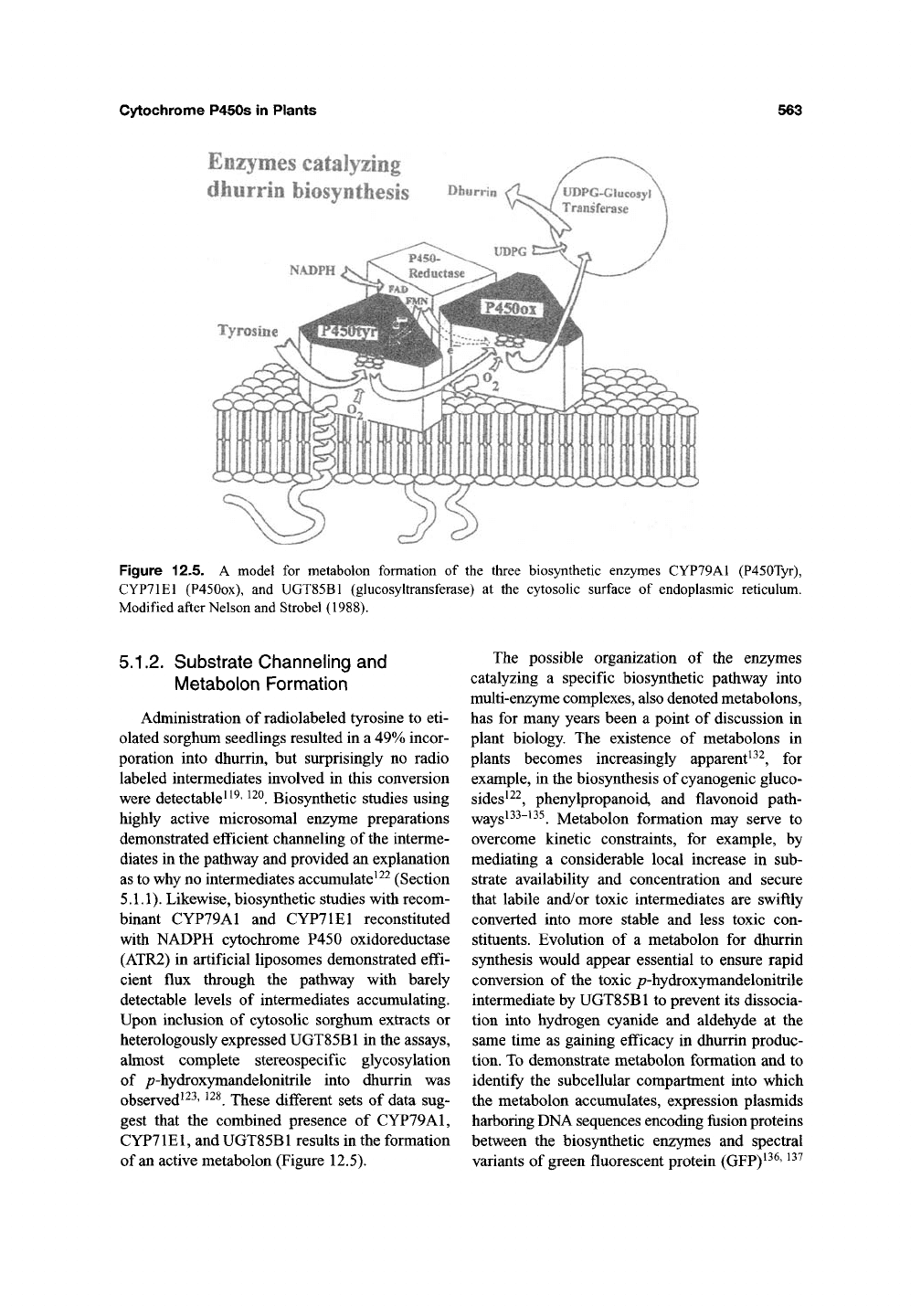
Cytochrome P450s in Plants
563
Enzymes catalysing
dhiirrm biosynthesis
Ohwrrin
Tyrosine
Figure 12.5. A model for metabolon formation of the three biosynthetic enzymes CYP79A1 (P450Tyr),
CYP71E1 (P450ox), and UGT85B1 (glucosyltransferase) at the cytosoUc surface of endoplasmic reticulum.
Modified after Nelson and Strobel (1988).
5.1.2. Substrate Channeling and
Metabolon Formation
Administration of radiolabeled tyrosine to eti-
olated sorghum seedlings resulted in a 49% incor-
poration into dhurrin, but surprisingly no radio
labeled intermediates involved in this conversion
were detectable^
^^'
^^°.
Biosynthetic studies using
highly active microsomal enzyme preparations
demonstrated efficient channeling of
the
interme-
diates in the pathway and provided an explanation
as to why no intermediates accumulate^^^ (Section
5.1.1). Likewise, biosynthetic studies with recom-
binant CYP79A1 and CYP71E1 reconstituted
with NADPH cytochrome P450 oxidoreductase
(ATR2) in artificial liposomes demonstrated effi-
cient flux through the pathway with barely
detectable levels of intermediates accumulating.
Upon inclusion of cytosolic sorghum extracts or
heterologously expressed UGT85B1 in the assays,
almost complete stereospecific glycosylation
of /7-hydroxymandelonitrile into dhurrin was
observed^^^' ^^^. These different sets of data sug-
gest that the combined presence of CYP79A1,
CYP71E1,
and UGT85B1 results in the formation
of an active metabolon (Figure 12.5).
The possible organization of the enzymes
catalyzing a specific biosynthetic pathway into
multi-enzyme complexes, also denoted metabolons,
has for many years been a point of discussion in
plant biology. The existence of metabolons in
plants becomes increasingly apparent^^^, for
example, in the biosynthesis of cyanogenic gluco-
sides^^^,
phenylpropanoid, and flavonoid path-
ways^^^"^^^.
Metabolon formation may serve to
overcome kinetic constraints, for example, by
mediating a considerable local increase in sub-
strate availability and concentration and secure
that labile and/or toxic intermediates are swiftly
converted into more stable and less toxic con-
stituents. Evolution of a metabolon for dhurrin
synthesis would appear essential to ensure rapid
conversion of the toxic /?-hydroxymandelonitrile
intermediate by UGT85B1 to prevent its dissocia-
tion into hydrogen cyanide and aldehyde at the
same time as gaining efficacy in dhurrin produc-
tion. To demonstrate metabolon formation and to
identify the subcellular compartment into which
the metabolon accumulates, expression plasmids
harboring DNA sequences encoding fusion proteins
between the biosynthetic enzymes and spectral
variants of green fluorescent protein (GFP)^^^' ^^^
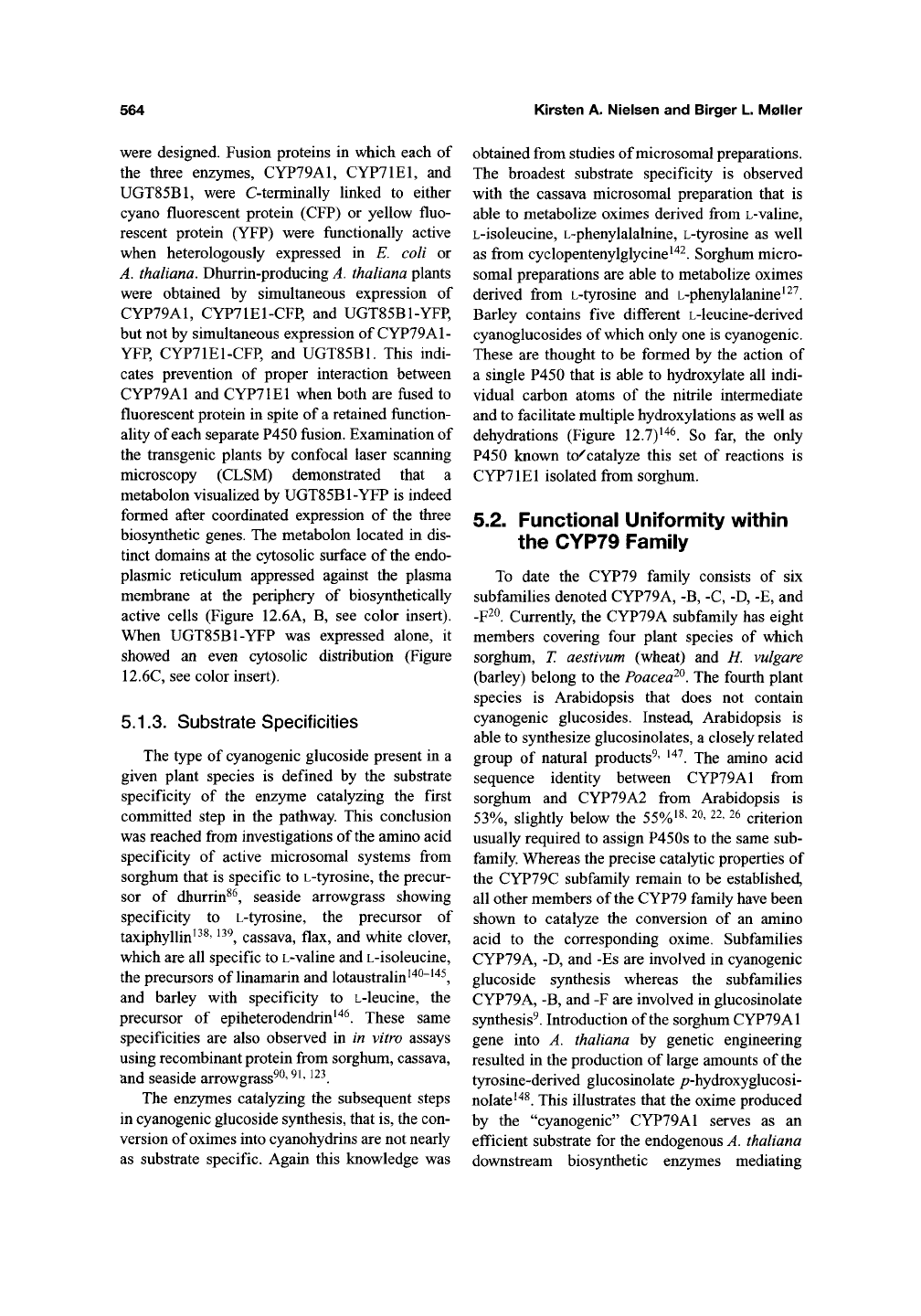
564
Kirsten A. Nielsen and Birger L. Moller
were designed. Fusion proteins in which each of
the three enzymes, CYP79A1, CYP71E1, and
UGT85B1,
were C-terminally linked to either
cyano fluorescent protein (CFP) or yellow fluo-
rescent protein (YFP) were functionally active
when heterologously expressed in E. coli or
A.
thaliana. Dhurrin-producing A. thaliana plants
were obtained by simultaneous expression of
CYP79A1,
CYP71E1-CFP, and UGT85B1-YFP,
but not by simultaneous expression of
CYP79A1-
YFP,
CYP71E1-CFP, and UGT85B1. This indi-
cates prevention of proper interaction between
CYP79A1 and CYP71E1 when both are fused to
fluorescent protein in spite of a retained function-
ality of each separate P450 fusion. Examination of
the transgenic plants by confocal laser scanning
microscopy (CLSM) demonstrated that a
metabolon visualized by UGT85B1-YFP is indeed
formed afler coordinated expression of the three
biosynthetic genes. The metabolon located in dis-
tinct domains at the cytosolic surface of the endo-
plasmic reticulum appressed against the plasma
membrane at the periphery of biosynthetically
active cells (Figure 12.6A, B, see color insert).
When UGT85B1-YFP was expressed alone, it
showed an even cytosolic distribution (Figure
12.6C,
see color insert).
5.1.3. Substrate Specificities
The type of cyanogenic glucoside present in a
given plant species is defined by the substrate
specificity of the enzyme catalyzing the first
committed step in the pathway. This conclusion
was reached from investigations of the amino acid
specificity of active microsomal systems from
sorghum that is specific to L-tyrosine, the precur-
sor of dhurrin^^, seaside arrowgrass showing
specificity to L-tyrosine, the precursor of
taxiphyllin^^^' ^^^, cassava, flax, and white clover,
which are all specific to L-valine and L-isoleucine,
the precursors of linamarin and lotaustralin'^^"^^^,
and barley with specificity to L-leucine, the
precursor of epiheterodendrin^"^^. These same
specificities are also observed in in vitro assays
using recombinant protein from sorghum, cassava,
and seaside arrowgrass^^'
^i'
^23
The enz3niies catalyzing the subsequent steps
in cyanogenic glucoside synthesis, that is, the con-
version of oximes into cyanohydrins are not nearly
as substrate specific. Again this knowledge was
obtained from studies of microsomal preparations.
The broadest substrate specificity is observed
with the cassava microsomal preparation that is
able to metabolize oximes derived from L-valine,
L-isoleucine, L-phenylalalnine, L-tyrosine as well
as from cyclopentenylglycine^^^. Sorghum micro-
somal preparations are able to metabolize oximes
derived from L-tyrosine and L-phenylalanine^^^.
Barley contains five different L-leucine-derived
cyanoglucosides of which only one is cyanogenic.
These are thought to be formed by the action of
a single P450 that is able to hydroxylate all indi-
vidual carbon atoms of the nitrile intermediate
and to facilitate multiple hydroxylations as well as
dehydrations (Figure 12.7)^"*^. So far, the only
P450 known to^'catalyze this set of reactions is
CYP71E1 isolated from sorghum.
5.2. Functional Uniformity within
the CYP79 Family
To date the CYP79 family consists of six
subfamilies denoted CYP79A, -B, -C, -D, -E, and
-F^o.
Currently, the CYP79A subfamily has eight
members covering four plant species of which
sorghum, T. aestivum (wheat) and H. vulgare
(barley) belong to the
Poacea^^.
The fourth plant
species is Arabidopsis that does not contain
cyanogenic glucosides. Instead, Arabidopsis is
able to synthesize glucosinolates, a closely related
group of natural products^'
^^'^.
The amino acid
sequence identity between CYP79A1 from
sorghum and CYP79A2 from Arabidopsis is
53%,
slightly below the 55%i^'
^o,
22,
26
criterion
usually required to assign P450s to the same sub-
family. Whereas the precise catalytic properties of
the CYP79C subfamily remain to be established,
all other members of the CYP79 family have been
shown to catalyze the conversion of an amino
acid to the corresponding oxime. Subfamilies
CYP79A, -D, and -Es are involved in cyanogenic
glucoside synthesis whereas the subfamilies
CYP79A, -B, and -F are involved in glucosinolate
synthesis^. Introduction of the sorghum CYP79A1
gene into A. thaliana by genetic engineering
resulted in the production of large amounts of the
tyrosine-derived glucosinolate p-hydroxyglucosi-
nolate^"^^. This illustrates that the oxime produced
by the "cyanogenic" CYP79A1 serves as an
efficient substrate for the endogenous A. thaliana
downstream biosynthetic enzymes mediating
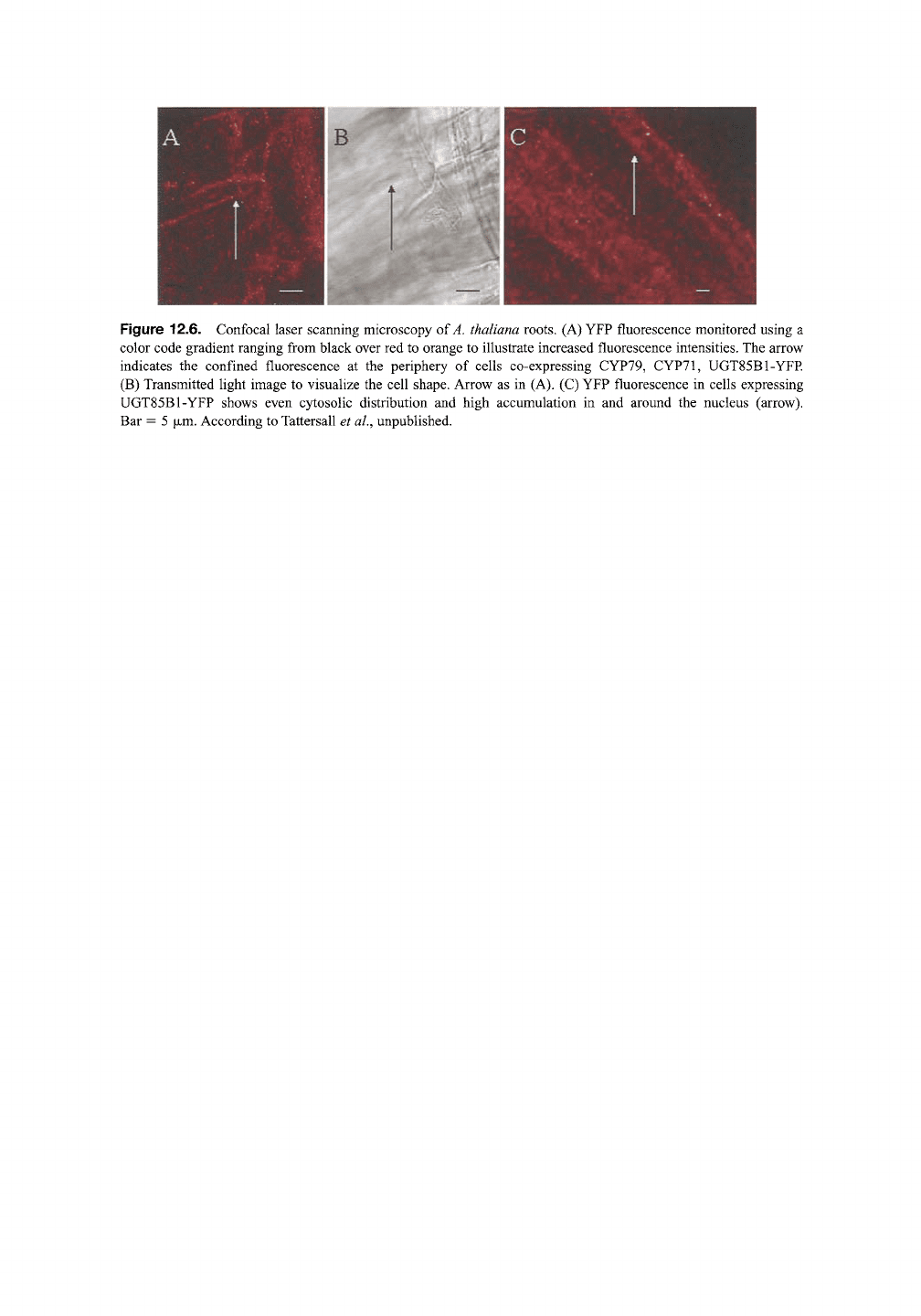
Figure 12.6. Confocal laser scanning microscopy of ^. thaliana roots. (A) YFP fluorescence monitored using a
color code gradient ranging from black over red to orange to illustrate increased fluorescence intensities. The arrow
indicates the confined fluorescence at the periphery of cells co-expressing CYP79,
CYP71,
UGT85B1-YFP.
(B) Transmitted light image to visualize the cell shape. Arrow as in (A). (C) YFP fluorescence in cells expressing
UGT85B1-YFP shows even cytosolic distribution and high accumulation in and around the nucleus (arrow).
Bar = 5
|jLm.
According to Tattersall et ah, unpublished.
